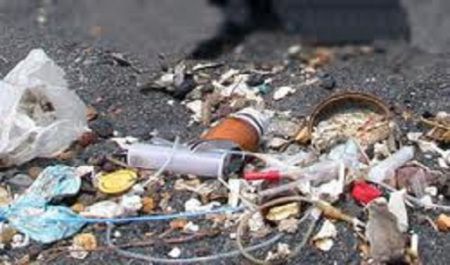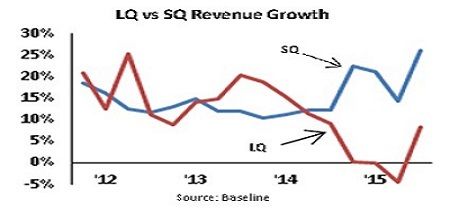
The future outlook for Stericycle (NYSE: SRCL) is hazardous.
The Trump administration has put the “Repeal of Obamacare (Affordable Care Act)” and “Deregulation” as two top priorities. Both are the foundation for Stericycle’s business model. As a result, SRCL has lost more than 50% since October 2016, relative to S&P 500.

Stericycle’s Business Model
1. Benefit from Heavily Regulated Medical Waste Disposal Industry
The U.S. Medical Waste Industry has been one of the most regulated industries. With increasing regulations from both U.S. Drug Enforcement Agency (DEA) and Environmental Protection Agency (EPA) for proper disposal of expired pharmaceuticals, staying compliant to these regulations is becoming more expensive for companies that have their own on-site disposal management. For small quantity companies (SQ) that outsource waste and pharmaceutical disposal, Stericycle is in the perfect position to gain them as the most profitable customers (see Figures below).

2. Technological Advances to Meet EPA’s Standards
EPA regulations require companies to destroy any living cells on medical waste. Stericycle has a patent-protected technology called electro-thermal deactivation, which gives them the ability to kill all living cells on medical waste faster than anyone else, and for half the cost. This technology also has zero toxic emissions, making them the only waste specialist that has no adverse effects on the environment. Other acceptable gas emissions from waste services have strict limits placed on the amount of emissions allowed. Stericycle’s emissions are less than half of these allowed amounts.
3. Acquisitions for Growth
Stericycle has an aggressive acquisition strategy in which they purchase companies with similar business models (see Figure below). They focus on finding companies that are compliance-driven and route-based with recurring revenue and multi-year contracts. The markets they target are highly fragmented and are composed of many regionally-focused entities. They integrate and leverage acquired companies to gain huge economies of scale. As a result, Stericycle provides their customers with prices lower than any competitor, which is the main driver behind their 95% customer retention rate. Also, the company has over 600,000 customers with over 95% of their revenues under long- term contracts, which hinders their competitor’s ability to enter this space.

Stericycle is one of the very few companies which crafted a successful business model to take advantage of the mere existence of government regulation. In addition, the U.S. had been experiencing higher medical care spending rates since the advent of Obamacare. Since 2014, Obamacare insured over 11 million U.S. citizens. Increased medical spending is highly correlated with revenues from the Medical Wastes and Services Industry.
As a result, during the 8-year Obama era till early 2016, SRCL had enjoyed a total return over 200%, compared to 65% of the S&P 500.
Broken Business Model
However, the exact same reasons for Stericycle’s success have become its curses.
1. Repeal of Obamacare
For any degree of modification on Obamacare means reduction in total coverage, medical spending, and the resulting waste and disposal. The negative impact on the entire industry and Stericycle is straight ford. The 4% annual growth in medical spending and 15% SRCL revenue growth in the last 5 years may be under suspect (see Figure below).

2. Deregulation
President Trump has claimed that federal agencies need to cut two existing regulations for every new regulation it implements. Since the healthcare, medical and bio hazardous waste disposal industries are heavily regulated by federal agencies, they are most likely going to be affected by this executive order.
Moreover, Tom Price, the secretary of the Department of Health and Human Services and Seema Verma, the administrator of the Centers for Medicare and Medicaid Services, both newly appointed, have proposed and passed legislation that made it harder for people to reap the benefits of Medicaid. It is likely that more people will lose coverage, which would cause revenues from the Medical Waste and Services Industry and from Stericycle to decrease. Scott Pruitt, who also has a long reputation of objecting federal regulation, has been appointed to be the new chief of the EPA.
3. Limited Growth Potential
Stericycle is going to have to accept lower prices. If the company wants to hold on to the revenues from 2016, the volume of sales has to increase. Unfortunately for Stericycle, there is nothing that points at such an increase happening in 2017. If anything, sales volume will decrease because of more lenient regulations in the medical and bio hazardous waste disposal.
The negative outlook on organic growth also spills over the acquisition growth of the company. In the period of 2013 – 2015, the number of acquisitions that Stericycle has made each year already decreased from 49 to 42 acquisitions. The dollar amount has declined from over 500 million to 200 million in 2015. Actually, loosening regulation will dis-incentivize the smaller quantity companies to outsource the waste and disposal services. Stericycle might not be able to find as many companies to acquire in the future. As Stericycle primarily acquired smaller companies in the industry in order to gain a competitive advantage in the form of economies of scale, it is highly doubtful that this model, which Stericycle relies upon for growth, will work when fewer companies will enter the market.
Stericycle is not only competing against companies that offer similar services, but is also striving to capture the share of the market that is still being served by on-site waste management facilities. The intense competition in the market forces Stericycle to accept relatively low prices, which is evident in its investor relation’s presentation in Q3, 2016 in which the company announced its assumption of total price concessions of $10-15M and $30-40M in 2016 and 2017 respectively. These forced price cuts will negatively affect Stericycle’s future revenues. Stericycle has a 17% U.S. market share, with a 10% global market share that dropped from 11% one year ago.
4. More Bad Fundamental News
Stericycle has missed three earnings or revenue estimates in 2016. One of the main reasons was that the additional revenue from the $2 billion acquisition, Shred-it was below original expectations. The acquisition was closed on October 1st, 2015. Revenue for Q4 2015 was $888.3 M, close to 24% higher than the quarter before. Selling and administrative expenses rose to $179.3 M in Q4 2015, up almost 90% from the quarter before. Factors that played a big role in the change in revenue were the acquisition of Shred-it and unfavorable currency exchange rates for a company that gets 28% of its income from abroad. In February 2017, Stericycle has written down approximately $65 to $75 million worth of assets because of disposal or because they’ve been marked to sell. This indicates that future international revenue streams are likely to decrease.
Forward Looking: Clinical Not Political
For the past 12 months, SRCL shareholders have lost around 50% relative to S&P 500. As nearly 30% loss was associated with earnings misses, it stands to reason that the remaining 20% can only be accounted by the changes in the political and regulatory environment (see Table below). Our assessment is that the volatility of the fundamental can be tolerated by the shareholders, especially there was some relief on the most recent earnings front.

Adverse Regulatory Environment Inevitable
Clearly, Stericycle takes a full frontal blow from deregulation and the repeal of Obamacare because they are in the medical waste industry. For comparison, the company Waste Management (NYSE: WM), in the similar waste management industry, is not affected by the new administration as they are not nearly as regulated as Stericycle. SRCL has underperformed WM by 15% since the election (see Figure below).

As investors, we are required to access the political probability of the realization of deregulation in the medical waste industry. Recently, Trump’s administration and his critics have been focused on the more controversial issues such as the travel ban, immigration, trade restriction, Obamacare, boarder taxes, and building the wall. This allows Price, Verma and Pruitt to deregulate under the radar and progress more swiftly. That is not good news for Stericycle.
From this point on, we are not optimistic about what Stericycle is facing. Most of the bigger picture risk, such as deregulation, repeal of Obamacare, and currency headwinds are beyond the company’s control. More importantly, both regulations and Obamacare were the foundation of Stericycle’s business model. The uncertain outlook would undermine the company’s acquisition activities, which were a major growth driver. And it did.
Ironically, while the entire nation is celebrating the deregulation, Stericycle is the first victim of two main policies of Trump’s administration.
That being said, it seems irrelevant to speculate whether the company beats or misses Q4 2016 earnings on February 15, 2017.
